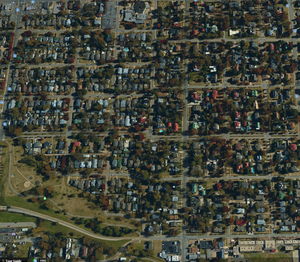 Maple Ridge North, including Lee Elementary on the bottom right, and Peoria up top.
Maple Ridge North, including Lee Elementary on the bottom right, and Peoria up top.
Maple Ridge
Maple Ridge has existed in Tulsa since 1912. It is listed on the National Register of Historic places. It is regarded as one of the most historic residencies in Tulsa, as it's colonial homes coincided with the Glen Pool oil boom of 1905 and a Crushing boom of 1912. These two prosperous events gave way the fortune of many oil businessmen, who directed their funds towards establishing a neighborhood on the south side of the railway tracks. It consists of predominantly colonial inspired architecture, all constructed within the same thirty year period. Most of the residences range from $300,000 to $3,000,000, varying by address. It was originally thought to be a poor place to invest such rich money, as it was on the "wrong side" of the near-by railroad tracks, but that proved to be a shallow prospect.
 One of the relic homes of the neighborhood.
One of the relic homes of the neighborhood.
The Highway Conflict and Maple Ridge Association
In the 1960s, Maple Ridge's existance became threatened by the city of Tulsa. The city planned to pass a bill allowing a $6.5 million dollar buyout of a majority of the land in Maple Ridge, and construct a highway through it. The idea was to provide the city with a central connection to downtown from the south and west.
The Maple Ridge Association, founded in 1964, responded to this proposal with a bias of defense for their homes. At this point many of the houses had been up for half a century and they MRA (Maple Ridge Association) intended of using this to their advantage. They began an effort to establish the neighborhood as a historic landmark, effectively preventing from alteration or destruction of the homes. Along with this tactic, which had succeeded in the early 70's, the foundation toured many of their homes to the media, and had many open houses to the public. At one point, designers interested in the homes put together a bus that would escort people around the neighborhood and visit open houses available en mass. Eventually these efforts proved successful, with the area still remaining untouched and now with many of the houses adorned with badges of historic value.
Many of MRA's tactics, though, were not just indirect ruses to oppress the city from the highway construction. They would often directly contact the Mayor and Governor, proposing alternate routes of the highway to be built that were capable of cutting costs by $4+ million. They made pleas to the city in public forums, speaking of the inhumane treatment of such established, and beautiful homes. Their main argument was the cost. The city had evaluated around 1960 that the buyout of Maple Ridge alone would cost them $6,500,000. This was actually an old and poorly calculated estimate. Ten years later, MRA members would calculate that the cost of construction through Maple Ridge could potentially double that number. Essentially, they pressed the city of the financial instability of the matter. In fact, the buyout was delayed and vetoed many times due to lack of funds from the city. The MRA's evaluation proved to be correct.
The city, on the other hand, paired the bill to destroy Maple Ridge with many other popular builds. They pandered to the public by asking them to sacrifice the neighborhood to pass other bills that would benefit them. This was futile though, as the city did not have the funds to buy Maple Ridge anyway.
 Clipping of a newspaper article from 1968 concerning the highway's construction.
Clipping of a newspaper article from 1968 concerning the highway's construction.
Lee Elementary
Lee Elementary is a primary school on the edge of the neighborhood, on South Cincinnati Avenue. It offers education to K-5. Lee was a strong force in the fight for the neighborhood's perpetuation. Often, as seen above, newspapers and magazines would refer to the destruction of this school as an unjustifiable act, further pleading to the sympathy of Tulsa.
 Front of Lee Elementary, bordering Cincinnati and 21st st.
Front of Lee Elementary, bordering Cincinnati and 21st st.
Parallels to city destruction via warzones
In areas of war, homes are often taken by government (sometimes foreign) forces without the cooperation of the residents. Usually via artillery, and in Japan’s case, Cruel Bombs.The main difference of the Maple Ridge incident was that the residents, being rich and expected to be payed off by the government for the property value, have a safety net of wealth to lift them from any issues that would otherwise drown them financially. This would have been a great opportunity for intellectual peace advocates to draw sympathy, asking the community to look at their own eviction situation in maple ridge and ask themselves what it would be like if the Maple Ridge Association were unable to fight back, if all of their material possessions were destroyed, and if they were given no reimbursement for their troubles. While being relocated is frustrating, being bombed out of your home is devastating. Even though the city of Tulsa were expected to pay off the homeowners of the area, does money alter their motivations from paralleling that of aggressive governments destroying homes with weapons?



